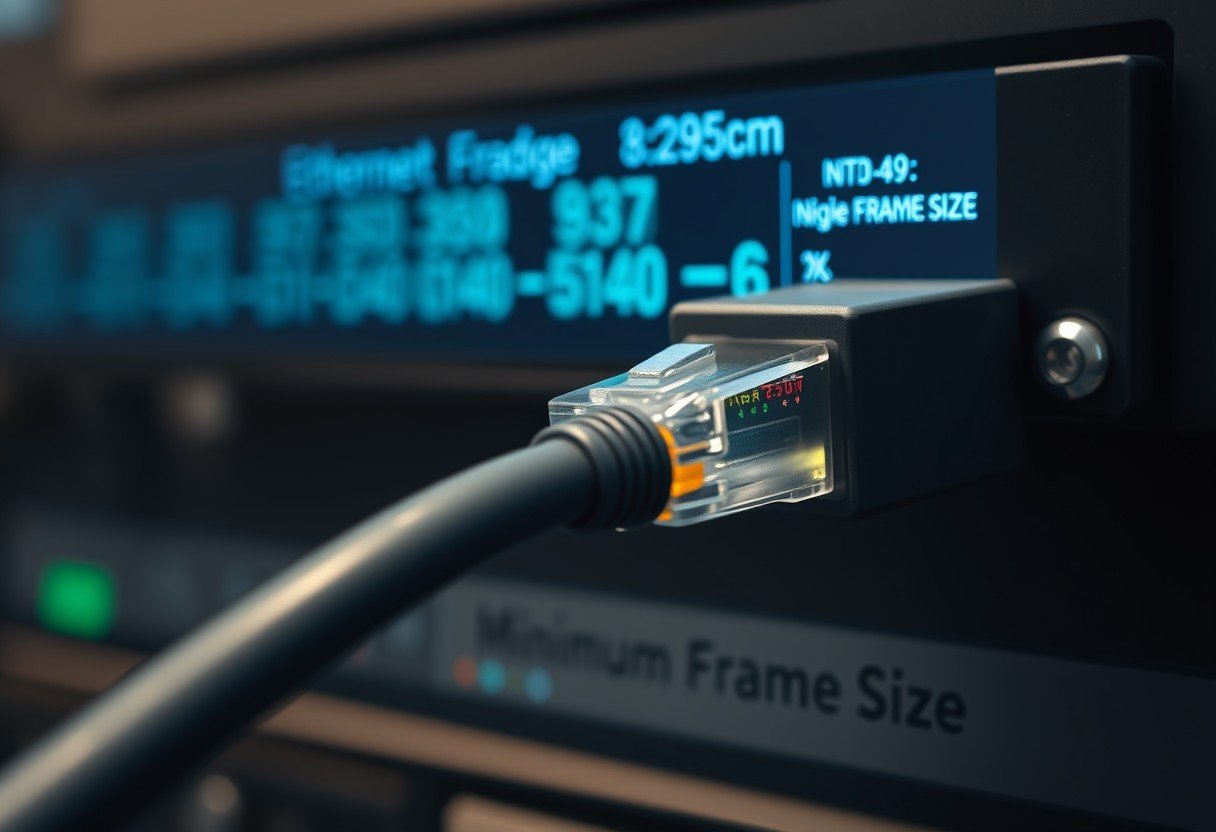In the world of networking, size matters. To ensure your data packets arrive safely and your network runs smoothly, they must meet a minimum size requirement. If a data packet, or frame, is too small, it gets labeled as a “runt frame” and is discarded. This guide explains what the minimum Ethernet frame size is, why this rule exists, and how you can prevent runt frames from disrupting your network’s performance and data integrity.
What Exactly Is an Ethernet Frame?
Think of an Ethernet frame as a structured envelope for sending data across a network. It’s not just the data itself; it’s a complete package with all the information needed for a successful delivery. This format allows different devices on a network to communicate reliably.
Each frame is built from several distinct parts that work together. Understanding these components helps clarify why a minimum size is necessary for the entire package to be valid.
The core components of a standard Ethernet frame include:
- Preamble: A sequence that signals the start of a frame and helps devices synchronize.
- Destination and Source MAC Addresses: The physical addresses of the receiving and sending devices.
- EtherType/Length: A field that identifies the protocol of the data inside or specifies the length of the payload.
- Payload: The actual data you are sending, such as part of an email or a web page.
- Frame Check Sequence (FCS): A value used for error detection to ensure the frame wasn’t corrupted during transmission.
Understanding Runt Frames and Why They Occur
A runt frame is any Ethernet frame that is smaller than the minimum allowed size of 64 bytes. When a switch or network interface card (NIC) receives a frame this small, it assumes something went wrong during transmission and immediately discards it.
These problematic frames don’t just appear out of nowhere. They are typically symptoms of underlying network issues.
The most common cause of runt frames is a collision, which happens in older half-duplex networks when two devices try to send data at the same time. The transmissions collide, creating fragmented, incomplete frames. Other causes include faulty network hardware, such as a malfunctioning network card, bad cabling, or driver issues.
The 64-Byte Rule: Breaking Down the Minimum Size
The requirement for a minimum frame size of 64 bytes is defined by the IEEE 802.3 standard. This rule wasn’t created arbitrarily; it was essential for the proper functioning of early Ethernet networks that used a system called CSMA/CD (Carrier Sense Multiple Access with Collision Detection).
To make up the 64-byte total, the frame structure has specific size requirements. This includes a 14-byte header (for MAC addresses and EtherType), a 4-byte FCS trailer for error checking, and a data payload.
This means that the data payload itself must be at least 46 bytes long. If the actual data being sent is less than 46 bytes, padding is automatically added to meet the minimum payload requirement. This ensures the total frame size reaches the 64-byte threshold and can be correctly processed by network devices.
How Runt Frames Negatively Impact Your Network
While discarding runt frames is a protective measure, a high number of them can seriously degrade your network’s performance. The immediate effect is packet loss, as the incomplete frames never reach their destination.
This packet loss forces the sending device to retransmit the data, consuming additional bandwidth and processing power. If the underlying issue causing the runts isn’t fixed, this cycle of transmission, collision, and retransmission continues.
Consequently, your network can experience increased latency, reduced overall throughput, and even congestion. For users, this translates to slower application performance, interrupted connections, and a frustrating experience. Effectively, the network is wasting resources trying to handle data that is destined to be dropped.
Practical Ways to Prevent and Mitigate Runt Frames
Fixing a runt frame problem starts with identifying the source. Since collisions are a major cause, upgrading from old hubs to modern switches can eliminate them, as switches create dedicated paths for communication.
However, if you are already using modern hardware, the issue likely lies elsewhere. You can take several steps to diagnose and resolve the problem.
- Check network interface statistics on your switches, routers, and computers for collision or error counts.
- Inspect physical network cables for damage or loose connections, and ensure they are of good quality.
- Update drivers for your network interface cards to the latest versions provided by the manufacturer.
- Replace any network hardware that is suspected of being faulty.
Regularly monitoring your network’s health is the best way to catch these issues early before they significantly impact performance.
How Ethernet’s Minimum Frame Size Compares to Other Protocols
While Ethernet’s 64-byte minimum is the most well-known standard, other networking protocols have their own rules for frame sizes. Understanding these differences is useful when working in environments with multiple network types.
The requirements vary based on the design and purpose of each protocol. Here is a quick comparison of the minimum frame sizes for a few different protocols.
| Network Protocol | Minimum Frame Size (bytes) |
|---|---|
| Ethernet | 64 |
| IPX | 78 |
| PPP | 4 |
| FDDI | 72 |
This table shows that protocols like IPX and FDDI require even larger minimum frames, while a simple protocol like PPP has a very small minimum.
Frequently Asked Questions
What is considered a runt frame in Ethernet?
A runt frame is any Ethernet packet smaller than the 64-byte minimum size. These frames are considered invalid and are typically dropped by network devices because they often result from collisions or transmission errors.
Why are frames smaller than 64 bytes problematic?
Frames below the 64-byte threshold are problematic because they can indicate a network fault. The minimum size was historically necessary to ensure devices could properly detect collisions, and discarding smaller frames helps maintain network stability by filtering out potentially corrupt data.
What happens to runt frames when they are detected?
When a network switch or router detects a runt frame, it will almost always discard it. This prevents the invalid frame from being forwarded and consuming network resources, ensuring that only valid, complete frames are processed.
Are there exceptions to the 64-byte minimum frame size?
For standard IEEE 802.3 Ethernet, the 64-byte rule is firm. However, some non-standard or proprietary implementations might use different frame structures, but in nearly all common networking scenarios, the 64-byte minimum is the standard to follow.









Leave a Comment